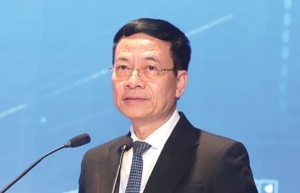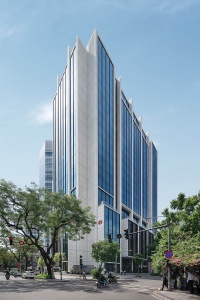Behind the numbers: Techcombank’s vision for growth
Techcombank's growth in total assets is projected to reach an impressive $41 billion in 2024. How did the bank achieve this milestone, especially considering the challenges in 2023 across both assets and liabilities?
 |
| Alex Macaire, CFO of Techcombank |
Like you said, 2023 was a challenging year. However, if we look at our business results for the year, we can see a strong turnaround, thanks to the robustness of our business model and our ability to predict and promptly adjust to market developments.
Techcombank's portfolio saw steady growth throughout 2023, with the bank's total profitable assets increasing by 23 per cent over the year.
In the first half of the year (H1), credit growth mainly came from corporate customers, then gradually shifted to the retail segment. This trend was consistent with the recovery of the retail real estate market as the year went on.
While this was an impressive result, our financials are more comprehensive than just the size of our goals balance sheet, and we were pleased to see upward momentum in most performance metrics.
This enables us to achieve strong profitability and maintain our number-one position in terms of average return on assets (ROA) in the entire market over the past five years.
Regarding the bank's revenue, we saw robust growth from service fees. Fee income is one of Techcombank's top priorities because it helps us diversify revenue, as well as improve capital efficiency.
Techcombank is proud to be the top bank in Vietnam in terms of fee income.
Our strong financial performance, despite economic headwinds, is one of the reasons why Techcombank was named 'Best Bank in Vietnam 2023' by US-based financial publication Global Finance. This award takes into account many criteria, such as financial and operational performance, customer offerings and experiences, technological innovation, and environmental and social impact.
Techcombank is witnessing a transition from corporate loans to consumer loans. Will this be a key direction for the bank in the coming year?
Our long-term strategy is to shift retail towards customer lending to help further diversify our credit exposure, enhance risk profile, and improve capital efficiency.
| With an abundant and stable CASA base, Techcombank has emerged as one of the industry leaders in profit margin. |
In 2023, we saw stronger demand for corporate lending activities compared to retail, but this did slow our credit diversification. However, as I mentioned, within our corporate credit book, non-real estate related lending grew over 60 per cent in 2023 compared to 2022 and we began to see a recovery in retail lending from the second half of 2023.
Techcombank applies a value chain approach to its lending activities. For example, in the real estate sector, the bank provides loans to investors to develop residential projects. When the projects are implemented, credit will flow to construction contractors, material suppliers, and finally to home buyers. Thus, cash flow circulates in our ecosystem and risks are spread across a diverse customer base in the value chain.
You mentioned using the value chain model to broaden the retail sector, mirroring the success seen earlier with real estate chain financing. Could you elaborate on this?
The creation of deep, strong partnerships and high professional expertise in funding value chains for high-profile projects in Vietnam is a key strength and an invaluable asset that Techcombank has accumulated over decades.
The bank is now looking to replicate the same approach in other sectors, beyond real estate and construction. This includes industries such as fast-moving consumer goods, utilities, automotive, finance, insurance, travel, and entertainment.
We'll start by crafting business models with key partners, gradually expanding to contractors, network suppliers, and ultimately consumers.
A good example of this strategy is the WinLife partnership with Masan, where Techcombank's innovative payment solutions and superior reward schemes are made available through more than 3,600 Winmart convenience stores across the country.
In each sector, the objective is to leverage the bank's unique relationship with one or more 'anchor' customers, and from there, develop a comprehensive set of transactions, credit and investment solutions catering to the needs of the various actors in the value-chain, starting from the suppliers all the way down to the final consumers.
Being able to deploy this deep value-chain expertise to access the best customers is an important differentiating value in the market. It has helped Techcombank achieve nearly zero credit defaults in its wholesale banking division, and build an unparalleled franchise in the high net-worth and affluent segments, establishing banking relationships with more than 50 per cent of customers in those segments.
Techcombank's CASA ratio rebounded significantly in 2023, nearing 40 per cent. However, that's still quite a distance from the 55 per cent target set for the 2021-2025 transformation journey. What's your take on this?
Our goal this year is to continue to grow our current account and savings account (CASA) balance and sustainably increase our CASA ratio, building on the strong momentum that we have seen in the latter half of 2023.
One of Techcombank's key strategic objectives is to lead in CASA ratio, and we remain totally focused on achieving a 55 per cent CASA ratio by 2025.
With an abundant and stable CASA base, Techcombank has emerged as one of the industry leaders in profit margin. The significant CASA volume lowers our cost of capital and enables us to offer competitive loan rates.
In addition, our success in the transformation journey over the past four years stems from our ability to compete with Vietnam's state-owned banks in terms of pricing and interest rate policies. Achieving a high CASA ratio is therefore integral to realizing our cost-effective capital strategies and driving business growth.
Techcombank has attracted attention with its intention to distribute cash dividends for the first time in a decade. Could you elaborate on this?
A decade ago, the bank decided to retain all profits to reinvest and expand business operations, while maintaining a high capital adequacy ratio (CAR). The objective was to be able to self-fund a stable and elevated growth rate of at least 20 per cent per year.
In the past 10 years, the bank has gone through quite an interesting journey. Whether in difficult or favourable market environments, we strived to promote our leading position in terms of digital transformation and effectiveness of business operations.
After a decade of growing profits at nearly 40 per cent per year, Techcombank has established itself as the leading private bank in Vietnam, delivering a cumulated pre-tax income in excess of $3 billion over the last three years.
Maintaining a strong profit generation capacity even in adverse environments was an important factor in our decision to start paying dividends. We acquired the confidence that we would be able to continue a business growth momentum above the industry average while keeping a Core Equity Tier 1 capital adequacy ratio of 14-15 per cent.
With the perspective of sustainable business and profit growth, the bank's Board of Directors has confidently proposed to start paying cash dividend from 2024 for shareholders to approve in the upcoming general meeting of shareholders on April 20.
Would paying cash dividends affect Techcombank's top position in terms of capital adequacy ratio (CAR)?
Given our bank's solid capital foundations and the strategic initiatives being implemented, I believe that paying cash dividends will not seriously impact the CAR ratio or any other financial indicators of Techcombank.
The bank will continue to maintain its growth momentum. Techcombank's story essentially reflects the inspiring journey of Vietnam's development.
The dividend plan has been carefully considered by our Board of Directors to bring outstanding value to our shareholders, in line with our objective to offer a unique and differentiated value proposition.
By investing into Techcombank's stock, shareholders can participate directly in a stream of income linked to the bank's financial performance, while retaining all the potential for upside coming from Techcombank's unique positioning in Vietnam's and regional market.
What is the bank's CAR target for this year?
We will maintain our CAR ratio from about 14-15 per cent.
 | The 2024 vision for digital application, digital productivity, and digital growth Vietnam's digital technology industry has made encouraging steps of development and maturity over the years. |
 | Vietnam's 40 years of new life and a 2045 vision highlight Australian and Vietnamese experts are collaborating to conduct a research series on 40 years of the doi moi policy and the country's progress towards high-income status by 2045. |
 | Moody's upgrades the outlook of Techcombank 2024 The credit rating organization Moody's on March 20 updated the outlook for Technological and Commercial Joint Stock Bank (Techcombank) to Stable. |
What the stars mean:
★ Poor ★ ★ Promising ★★★ Good ★★★★ Very good ★★★★★ Exceptional
Related Contents
Latest News
More News
- Miza Nghi Son green bond marks milestone for sustainable finance (January 19, 2026 | 09:51)
- Higher 2026 growth target puts pressure on credit framework (January 19, 2026 | 09:00)
- VN-Index could reach 2,040 points in 2026 (January 16, 2026 | 16:41)
- Vietnam’s corporate bond market set for a more positive 2026 (January 15, 2026 | 14:10)
- Foreign sentiment towards Vietnam turns more positive (January 15, 2026 | 11:08)
- Wealth management faces skills gap as investor confidence lags (January 13, 2026 | 10:23)
- HDBank completes $100 million international green bond scheme (January 12, 2026 | 16:28)
- Vietnam’s IPO market eyes revival in 2026 (January 09, 2026 | 17:28)
- Brokerage competition tightens as market shares narrow (January 09, 2026 | 15:19)
- Banks set for selective hiring in 2026 (January 08, 2026 | 10:56)

 Tag:
Tag:


























 Mobile Version
Mobile Version